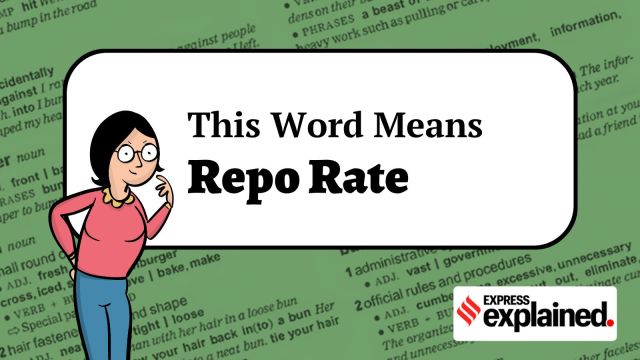This Word Means: Repo Rate
Every day, 500 words on a word (or expression) that has appeared in The Indian Express
 Repo rate is the rate at which the RBI lends to commercial banks.
Repo rate is the rate at which the RBI lends to commercial banks. Why now?
The Reserve Bank of India’s (RBI’s) six-member Monetary Policy Committee (MPC) on Wednesday (April 9) decided to cut the repo rate by 25 basis points to 6%. The rate setting panel also changed the monetary policy stance from “neutral” to “accommodative”, signaling further reductions in the repo rate in the near future.
What is repo rate?
People go to commercial banks either to deposit their savings or to get a loan. On savings/deposits, the bank pays interest to the depositor while on loans, it charges interest to the borrower. Typically, the interest rate banks charge on loans is higher than the interest they pay on deposits. This is how they make money.
A key deciding factor — although not the only one — is the interest rates that commercial banks themselves pay (or get) when they borrow (or deposit) money from (or in) the RBI. The interest rate that the RBI charges when commercial banks borrow money from it is called the repo rate. The interest rate the central bank pays commercial banks when they park their excess cash is called the reverse repo rate.
Currently, the repo rate is at 6% whereas the reverse repo rate is at 3.35%.
Why does the repo rate matter?
Using these two rates, the RBI sets the tone for all other interest rates in the banking system, and through that route, in the broader economy.
For instance, when the RBI wants to encourage economic activity in the economy, it reduces the repo rates. Doing this enables commercial banks to bring down the interest rates they charge (on their loans) as well as the interest rate they pay on deposits. This, in turn, incentivises people to spend money, because keeping their savings in the bank now pays back a little less, and businesses are incentivised to take new loans for new investments because new loans now cost a little less as well.
On the other hand, when the RBI wants to control inflation, it increases the repo rate. Banks thus have to pay more interest to borrow from the RBI, which means they will charge more interest to their borrowers. At a macro level, this inhibits people from borrowing money as well as from spending, which in turn reduces the amount of money in the market, and thus negates inflation.
It is for this reason that the repo and reverse repo rates are often referred to as the “benchmark” interest rates in the economy.
Why has RBI reduced the repo rate?
The central bank’s decision comes amidst heightened global economic uncertainty in the face of the far reaching reciprocal tariffs announced by the Donald Trump administration in the US.
“Global economic outlook is fast changing. FY26 has started on an anxious note and some global trade frictions are coming true,” RBI Governor Sanjay Malhotra said on Wednesday. He notably added that the central bank is “more worried” about a sluggish economy than inflation at the moment.
The January-February inflation is tracking an average of 3.9%, below the RBI’s quarterly projection for January-March 2025. The RBI has projected consumer price-based inflation (CPI) at 4.8% for the fourth quarter of the fiscal 2025.
- 01
- 02
- 03
- 04
- 05






































